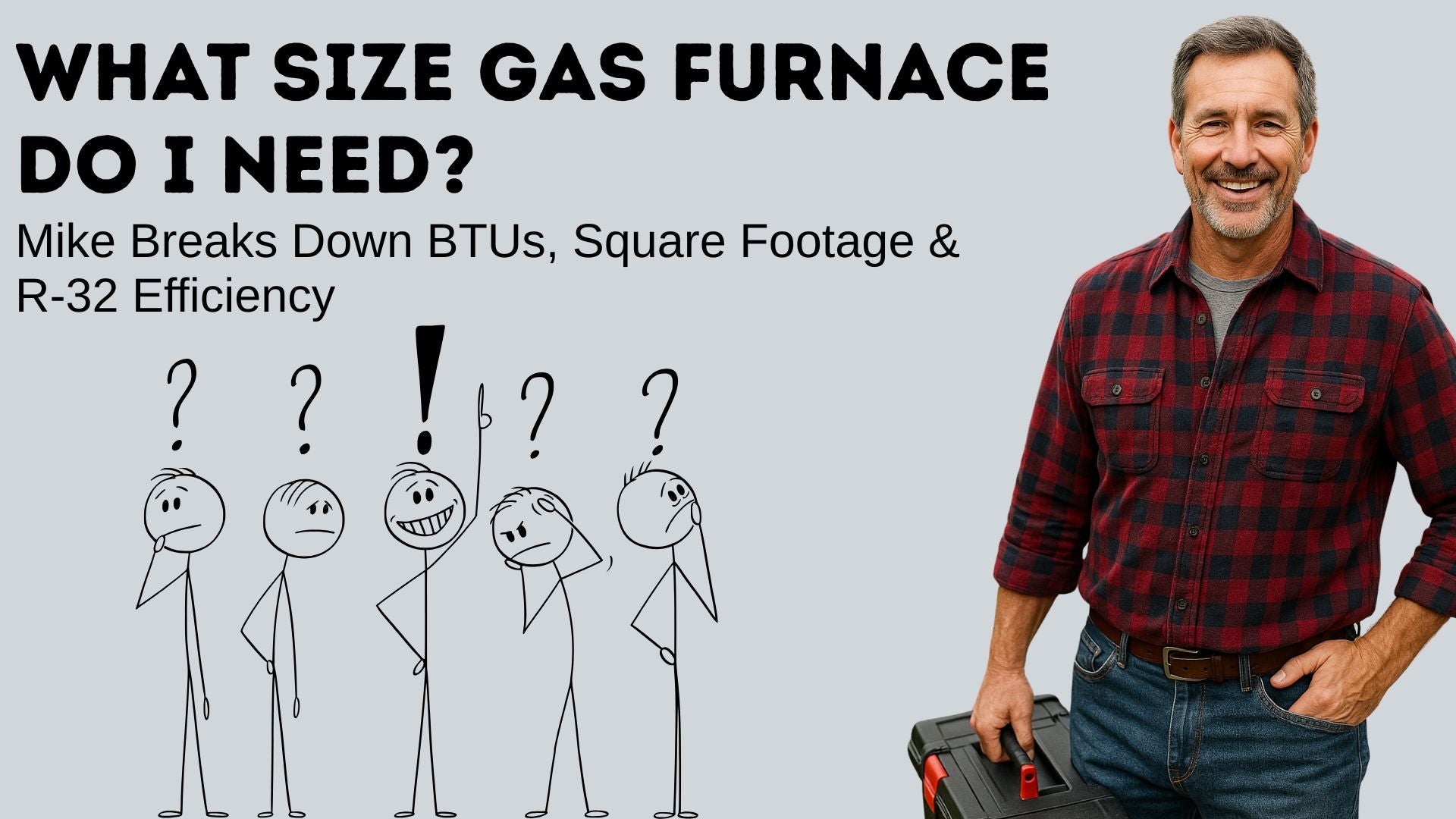🔧 Getting the Right Size Furnace (Not Too Big, Not Too Small)
Hey folks, Mike here.
If there’s one mistake I see over and over, it’s furnace oversizing. Homeowners think bigger is better, but a too-powerful furnace:
-
Kicks on and off too often (called short cycling)
-
Wears out faster
-
Heats unevenly
-
Wastes fuel
Instead, you want a furnace that’s sized just right for your home’s square footage, climate, and insulation levels.
📏 Quick Rule of Thumb: BTUs Per Square Foot
Most HVAC techs use this basic formula:
| Climate Zone | BTUs Needed Per Sq. Ft. |
|---|---|
| Hot (South) | 30–35 |
| Moderate | 35–45 |
| Cold (North) | 45–60+ |
Let’s say you’ve got a 2,000 sq. ft. home in a moderate climate.
2,000 × 40 = 80,000 BTUs
That means you'd typically want a furnace that delivers 75,000–85,000 BTUs of output.
👉 Keep in mind, that’s output—not input. A 100,000 BTU furnace with 80% AFUE delivers 80,000 BTUs of usable heat. But an R-32 gas furnace with 96% AFUE only needs 83,000 BTU input to deliver the same warmth.
More on AFUE here:
🔗 Energy.gov - Understanding Furnace Efficiency Ratings (AFUE)
🧊 Why R-32 Furnaces Make Sizing Easier
R-32-compatible furnaces are newer models with tighter efficiency ratings, meaning you can sometimes get away with a slightly smaller unit and still stay cozy.
Key Benefits:
-
Higher AFUE ratings (up to 98%)
-
More consistent heating with modulating burners
-
Less wasted heat = better value for your energy dollar
Plus, R-32 is paired with lower-GWP cooling units, so if you’re doing a full HVAC upgrade, your whole system will be more efficient and environmentally friendly.
Want to dig deeper?
🔗 AHRI Guide: Furnace & AC System Matching and Efficiency
🏠 Other Factors That Affect Furnace Sizing
Here’s what else I check when I do an in-home estimate:
✅ 1. Insulation Quality
-
R-19 in the attic? You’re good.
-
Drafty walls or old windows? You may need a bigger furnace or upgrade insulation first.
✅ 2. Ceiling Height
A vaulted 2,000 sq. ft. home needs more heating than one with standard 8' ceilings.
✅ 3. Ductwork
Bad ducts leak heat. You could be losing 20–30% of your furnace output before it hits the vents.
✅ 4. Location & Orientation
South-facing homes with lots of sunlight often require less heating than shaded or north-facing homes.
🔗 For pro-level sizing, check out Manual J Load Calculations Explained by HVAC School
🧮 Mike’s BTU Sizing Table for Quick Estimates
| Home Size (sq. ft.) | Cold Climate | Moderate Climate | Warm Climate |
|---|---|---|---|
| 1,000 | 50,000–60,000 | 40,000–45,000 | 30,000–35,000 |
| 1,500 | 70,000–80,000 | 55,000–65,000 | 45,000–50,000 |
| 2,000 | 90,000–110,000 | 75,000–85,000 | 60,000–70,000 |
| 2,500 | 110,000–130,000 | 90,000–105,000 | 75,000–90,000 |
Note: Choose an R-32 model with higher AFUE and you can often go with the lower end of the range.
🔍 Mike’s Top R-32 Furnace Picks by Size
🔥 For 1,500–2,000 Sq. Ft.
Goodman GR9T961005CN (96% AFUE, 100,000 BTU Input)
-
Two-stage heat = comfort and control
-
R-32 AC pairing compatible
🔥 For 2,000–2,500 Sq. Ft.
Amana Distinctions 120K BTU ULN Gas Furnace
-
Ultra-low NOx
-
Designed for stricter emissions codes
-
Built-in diagnostics
✅ Final Thoughts from Mike
Sizing a furnace isn’t just about matching BTUs to square feet—it’s about balancing comfort, efficiency, and local conditions. That’s where R-32 systems really shine: you get high-efficiency performance, cleaner operation, and easier compliance with modern codes.
If you’re not sure where to start, reach out to us at The Furnace Outlet and we’ll help size a system that fits your home (and budget).
Stay warm,
– Mike
In the next topic read about: What Is an R-32 Gas Furnace System—and Why Should Homeowners Care?







